Total of 320 entries from 206 organizations in 62 countries/regions were
submitted in the JAPAN PRIZE 2014.
On October 21st, the Grand Prix Japan Prize and all other awards were announced.
*Please click here to view the list of finalists and candidates for the four Special Prizes in the Audio Visual Division.
*Please click here to view the list of finalists in the TV Proposal Division.

The most outstanding work among all of the Audiovisual entries which excels in its ability to educate, in its pertinence to the requirements of the times, and in its contribution to educational media.
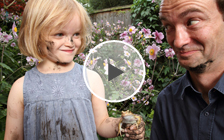 |
Title |
Project Wild Thing |
Media |
Film/Motion Picture |
| Entering Organization |
Green Lions
The BRITDOC Foundation |
Country/Region |
United Kingdom |
| David is the father of a five-year-old girl and three-year-old boy. When David was little, he loved to play outside. But now children including his own are hooked on screens and don’t want to go outdoors. It is thought such trends increase childhood obesity and mental illness all over the UK. So David appoints himself as the marketing director for a brand called Nature. With the help of branding and outdoor experts and psychologists, he makes posters, creates a website and launches a nationwide marketing campaign “Project Wild Thing” to get British children to go outside. A father’s thoughts start to change a society. |
|

Audiovisual Division The Best Work in Each Category
The Best Work in the Pre-school Category
(The Minister of Internal Affairs and Communications Prize)
The best work among educational audiovisual contents for pre-school children up to around age 6
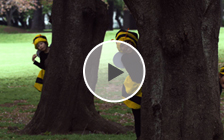 |
Title |
Mimicries - The Secret of Black and Yellow |
Media |
TV |
| Entering Organization |
Japan Broadcasting Corporation (NHK)
NHK Educational Corporation |
Country/Region |
Japan |
| Let’s look for lookalikes in nature, “mimicries”! What look like a bee’s black and yellow stripes? Longhorn beetles and some moths are similarly striped. You can find such stripes in railroad crossings or guard fences at construction sites. In the show, similarities or mimicries in life appear one after another, and young viewers naturally start to think about why they happen or their meanings. When children find mantises that look like dead leaves, they wear green ribbons and brown cloth to pretend to be grass or trees. Wood lice arch their backs; cats and armadillos do the same. Even we hunch our shoulders under our desks during earthquakes. The program’s mix-and-match approach using live-action video, animation, and songs invites children into the wonders of nature. |
|
The Best Work in the Primary Category
(The Minister of Education, Culture, Sports, Science and Technology Prize)
The best work among educational audiovisual contents for primary school children around ages 6 to 12
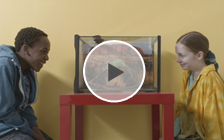 |
Title |
LIZARD GIRL |
Media |
TV |
| Entering Organization |
FEELGOOD FICTION Ltd. |
Country/Region |
United Kingdom |
| This drama’s heroine is a ten-year old girl with Asperger syndrome. She struggles to make friends at school but her only friend is her pet lizard. One day, she sees some boys skateboarding and wants to try it. She tries to make her own board but it breaks apart. A boy sees that she is very depressed and leaves his old board at her door. From the moment she gets on the board she practices hard by herself and finally she does beautiful skateboarding in public. When the boy visits her, she invites him to her room and shows him her dear lizard for the first time. |
|
The Best Work in the Youth Category
(The Minister of Foreign Affairs Prize)
The best work among educational audiovisual contents for youths around ages 12 to 17
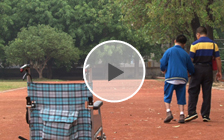 |
Title |
The ways to embrace imperfection |
Media |
TV |
| Entering Organization |
Daai Satellite TV |
Country/Region |
Taiwan |
| This is a ten-year record of watching a boy in Taiwan grow through childhood to college. Lin Yen-liang was born with cerebral palsy. Since he was very little, his father gave him foot massages every single day to help him walk. Even so, he has to endure how his classmates see him in school. In high school, Yen-liang makes a bunch of good friends. They do what they can to help him, such as cleaning his bed at lunchtime, taking him to the toilet and dealing with his feces. Yen-liang’s great sense of humor, his family’s deep affection and good friendships make his life a happy one. |
|
The Best Work in the Continuing Education Category
(The Governor of Tokyo Prize)
The best work among educational audiovisual contents that support adults for pursuing further education (around ages 18 and over)
 |
Title |
Project Wild Thing |
Media |
Film/Motion Picture |
| Entering Organization |
Green Lions
The BRITDOC Foundation |
Country/Region |
United Kingdom |
| David is the father of a five-year-old girl and three-year-old boy. When David was little, he loved to play outside. But now children including his own are hooked on screens and don’t want to go outdoors. It is thought such trends increase childhood ¬¬¬¬obesity and mental illness all over the UK. So David appoints himself as the marketing director for a brand called Nature. With the help of branding and outdoor experts and psychologists, he makes posters, creates a website and launches a nationwide marketing campaign “Project Wild Thing” to get British children to go outside. A father’s thoughts start to change a society. |
|
The Best Work in the Creative Frontier Category
(The Minister of Economy, Trade and Industry Prize)
The best work among educational audiovisual contents that has rich potential to support future education by taking advantage of the characteristics of media using fresh ideas and techniques (regardless of target audience)
 |
Title |
netwars / out of CTRL |
Media |
Cross Media |
| Entering Organization |
FILMTANK GmbH, MIIQO STUDIOS, ARTE/ZDF, BASTEI LUBBE |
Country/Region |
Germany |
| This work utilizes interactive websites as well as a TV documentary to show the danger that our computers connected on the net could be used to cause cyberwarfare. It shows total chaos in the world caused by computer virus attacks: power plant shutdowns, paralyzed traffic systems, and the collapse of financial systems. Also in the application for mobile devices that combines a graphic novel and game, users virtually participate in a possible cyberwar. Its cross-media expression through plural formats enables us to feel that the danger of netwars is quite real. |
|
Audiovisual Division Special Prizes
The Maeda Prize
An excellent work dealing with issues in a producer's country or region, which enlightens and encourages people toward finding a solution
 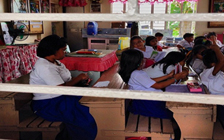 |
Title |
Reel Time: Nebulizer |
Media |
TV |
| Entering Organization |
GMA Network, Inc. |
Country/Region |
Philippines |
| Maribel is the mother of three schoolgirls. She herself grew up in a poor family and had to quit school in first grade. She cannot read nor write, so she is unable to help her daughters with their homework. At the age of 25, she decides to enroll in Grade 1 along with her eldest daughter. Feeling cold eyes on her, she keeps working to feed the family every day. Another trouble happens. Maribel and the eldest daughter suffer from asthma, and now the daughter’s condition is getting worse. Actually they deserve to get a free nebulizer from the local government, but she wasn’t able to write and submit the application for a long time. Maribel encourages herself to try to write the document. Her story presents how literacy building influences people’s lives. |
|
The Japan Foundation President’s Prize
An excellent work that encourages mutual understanding among nations and races or contributes to cultural exchange
 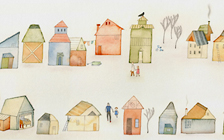 |
Title |
No Fish Where to Go |
Media |
Film/Motion Picture |
| Entering Organization |
National Film Board of Canada (NFB) |
Country/Region |
Canada |
| This animation quietly asks us how we accept different people and what discrimination is. The Red Shoes clan and the opposing clan live in a small village. While tension is growing, two girls from the two enemies strike up a close friendship. “You have two minutes to get out!” One morning, the Red Shoes force their way into one of the girl’s house. She barely gets out of the house with her pet fish in a fishbowl. They shoot her father and are going to take her mother, a baby and the girl with them. On the way, she manages to hand the fish to the other girl. At that moment, the girls feel sure of their firm friendship. |
|
The UNICEF Prize
An excellent work that promotes understanding of the lives of children in difficult situations
  |
Title |
Cinderella of grade 5 |
Media |
TV |
| Entering Organization |
Sri Lanka Rupavahini Corporation (SLRC) |
Country/Region |
Sri Lanka |
| Madushika, a 10-year-old girl, lives in a remote village in Sri Lanka. Due to illiteracy her father’s work is limited to physical labor, so the family of four including her little sister live from hand to mouth in a small hut. When she started to go to school, she was oppressed and suffered from an inferiority complex. However, teachers kept encouraging her to help her gain self-confidence. Her father takes her to and from school on a long, rough road every day. She realizes that the only way to escape poverty to grasp a bright future is education. Then she strives to pass a scholarship exam. Her success with high marks gives hope and honor to herself and her family, and even to the villagers. |
|
The President of NHK Prize
An excellent work in the welfare education field that provides ideas to create a mature and nurturing society.
 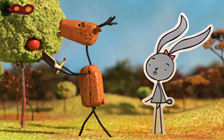 |
Title |
Rabbit and Deer |
Media |
Film/Motion Picture |
| Entering Organization |
Moholy-Nagy University of Art and Design |
Country/Region |
Hungary |
| Rabbit and Deer are happy and careless their friendship is put to the test by Deer’s new obsession to find the formula for the third dimension. After an unexpected accident, Deer finds himself in a new world, the third dimension. Separated by dimensions, the two friends have to find a way back to each other. Simple drawings and three-dimensional figures ingeniously express the contrast of the two dimensions. There is no dialogue but laughing voices and sound effects. This story conveys to us how important it is to maintain friendships both in good times and bad times and to accept each other's differences. |
|
TV Proposal Division The Best Proposal
The Hoso Bunka Foundation Prize
The most outstanding proposal for an educational TV program
  |
Title |
Meerkat's Adventure |
| Country/Region |
Namibia |
Entering
Organization |
Namibian Broadcasting Corporation (NBC) |
| In Namibia, the majority of children don’t have the opportunity to acquire the fundamental knowledge before primary school, such as letters, numbers, colors and shapes. Another challenge is that 13 languages are used in the country and little children in remote areas hardly learn English, which is used in primary schools. In this proposed magazine show, an animated inquisitive and adventurous Meerkat travels the African veld, savannahs, coasts and deserts to meet various animals. Through his adventures, kids have fun and learn about animals and nature, as well as acquire fundamental knowledge. It is expected that this program will serve as an opportunity for preschool children to get a good command of English and to experience the unknown world outside their villages. |
|

updated by the producer on December, 2014 |
TV Proposal Division Special Prize
The National Federation of UNESCO Associations in Japan Prize
An excellent proposal for a TV program, which contributes to the diffusion of basic education starting with literacy
 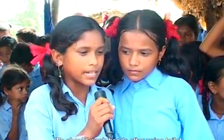 |
Title |
A Dalit Girl in Baijalpur Village |
| Country/Region |
Nepal |
Entering
Organization |
Media Help Line |
| In Baijalpur village of Nepal, the majority of people are called Dalit (untouchable caste), and are socially discriminated against and forced into poverty. Just 10 years ago, more than 65% of the village houses did not have toilets. Due to water contamination by open defecation, every year hundreds of children died because of diarrhea. In 2005, a 13-year-old Dalit girl led a team of students and began a sanitation campaign to convince their parents to make home toilets. Finally, every house in the village has a toilet and sanitation in the area has much improved. Then movement then spread to neighboring villages. The purpose of this documentary is not only to raise awareness of sanitation but also to convey to children the importance of taking action themselves. That would help the Dalit people who suffer from discrimination to gain self-confidence. |
|

![]()













